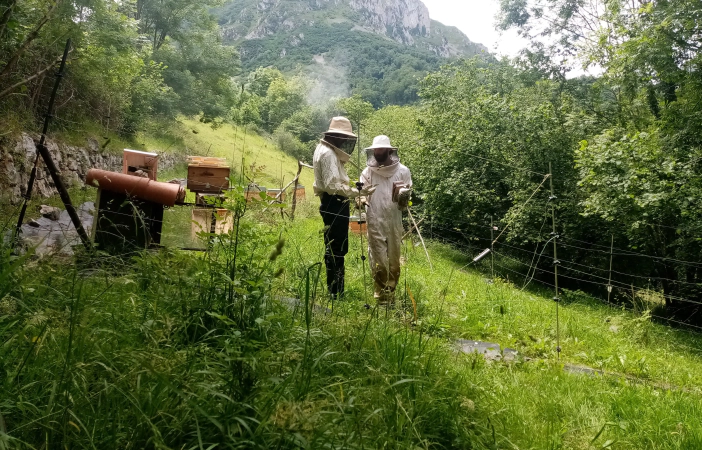
In short: Yes, bee suits do protect against wasps. They’re made of a material that wasps can’t sting through, so as long as you’re wearing the suit correctly and it’s sealed up nicely, you’ll have nothing to worry about.
Why Bee Suits Protect Against Wasps
The reason why bee suits protect against wasps is because they’re made out of a material that wasps are unable to sting through, and they’re designed to be worn in such a way that there are no gaps where a wasp might be able to get through.
How Bee Suits are Made
Bee suits are made out of a material called “Ventilated Cotton,” which is special because it’s able to keep you cool even when you’re wearing a long-sleeved suit and trousers that cover your entire body.
The material is woven quite loosely, which allows air to pass through and cool you down, but it also has the effect of providing you with a lightweight and flexible suit that you can move around in comfortably.
Unlike the thick, stiff material that wasp suits are made out of, this means that you can wear a bee suit for longer periods of time without getting sweaty or uncomfortable.
On top of that, it’s also much easier to clean a bee suit than it is to clean a wasp suit, because you can put a bee suit in the washing machine without it getting all twisted and scrunched up like a wasp suit would if you tried to do the same thing with it.
How Bee Suits are Designed
Bee suits are designed to be worn with gloves and a hat that has a veil, so that there’s no way for a wasp to get at your skin.
The gloves and hat that have veils are sold separately to the bee suit, but they’re really not that expensive, and they’re definitely worth getting, because if you don’t have a hat with a veil, then a wasp might be able to sting you through your hair, which wouldn’t be a nice thing to experience.
The veil is made out of the same material as the bee suit, and it’s attached to the sides of the hat with zips, so that you can detach it from the hat and machine-wash it separately.
The reason why the hat and veil are separate, rather than being a single piece of material that you put on like a balaclava, is because the veil is delicate and can get damaged in the washing machine if it’s not protected inside the hat.
How to Wear a Bee Suit
There’s a certain way to wear a bee suit that makes it effective at preventing wasps from getting at your skin, and also keeps it nice and cool at the same time.
The first thing you need to know is that the trousers of a bee suit are attached to the top part of the suit, so that there’s no way for a wasp to get at your skin.
They’re attached with a zipper, so it’s really easy to put the suit on and take it off.
The next thing you need to know is that the hat with the veil goes on over the top part of the suit, and that the veil is attached to the sides of the hat with zips.
By zipping the veil to the top part of the suit, you’re sealing up any gaps where a wasp might be able to get through, and you’re also keeping the veil nice and taut, so that it doesn’t hang in your face.
How to Seal Up a Bee Suit
By far the most important part of wearing a bee suit is how you seal up your suit around your gloves and boots.
Bee suits will often come with elasticated cuffs at the wrists and ankles, but you can’t rely on them to keep the wasps out, because wasps can easily crawl up your suit, and they’ll be able to get in as soon as they reach your wrists or ankles.
What you need to do is to secure your suit with duct tape around your gloves and boots, to make sure that there are no gaps where a wasp might be able to crawl in.
Make sure to tape your gloves or boots over the top of your suit, so that the wasps can’t crawl up under your suit and into the gloves or boots.
This is the most important part of wearing a bee suit, because if you don’t seal up your suit properly, then wasps will be able to get at your skin, and you’ll likely get stung.
Don’t worry too much about the wasps getting in through the zipper of the suit, because the zipper is actually at the back of the suit, and you’ll have the top of the suit overlapped with the trousers of the suit, so that there’s no way for a wasp to get at your skin.
Of course, you’ll still want to tape over the zipper, just to be safe, so that you don’t get any wasps crawling around inside your suit. It’s annoying to have to deal with them while you’re working, and it can be pretty uncomfortable if you get stung.
How to Put on a Bee Suit
Putting on a bee suit can be a little bit fiddly if you’ve never done it before, but it’s actually quite simple once you know how to do it.
First of all, you’ll want to put on some gloves before you start putting on your suit, because it’ll be pretty much impossible to put on your gloves if your suit is sealed up properly.
Next, you’ll want to put on your hat with veil, so that you can see what you’re doing when you’re putting on your suit.
After that, it’s just a case of stepping into your suit and pulling it up over your body. It’s a little bit like putting on a onesie, except that you’ll want to make sure that your gloves are taped up over the top of your suit before you pull your suit right up.
Getting the Right Size
Bee suits come in a range of sizes, but they’re generally pretty loose fitting, so you should be able to find a size that fits you well enough, even if you’re a little bit shorter or taller than average.
If you’re more on the heavier side, then you’ll want to get a size that’s a little bit bigger, because you don’t want your suit to be too tight against your skin, as it’ll be really uncomfortable if it is.
You’ll probably want to get a size up, while also getting a belt to keep things nice and secure.
It’s a good idea to get a belt anyway, because it’ll help to keep your suit sealed up around your waist, and wasps will have a difficult time trying to crawl up your legs if your trousers are secured tightly with a belt.
Do Bee Suits Work Against Other Insects?
Bee suits are designed to protect against large insects, such as wasps, hornets, and bees, but they won’t protect against small insects, such as gnats, midges, or mosquitos.
The reason for this is because small insects can get through the material of a bee suit, so you’ll need to wear some sort of additional protection if you’re going to be working with them.
The good news is that you can wear pretty much whatever you like under a bee suit, so it’s a simple case of wearing some long-sleeved trousers and a shirt, or even a mosquito suit, depending on how bad the small insects are.
If you’re going to be working with large and small insects at the same time, then your best bet is to buy a bee suit that has a built-in mosquito head net, so that you can keep the small insects off your face without having to wear two separate suits.
The head net is basically a long veil that hangs down from your hat, and you can wear it like a scarf, so that it keeps your face nice and cool, while also protecting it from small insects.
As always, make sure to secure your suit tightly with duct tape around your wrists and ankles, to make sure that the small insects don’t have a way of getting inside your suit.
In Summary
Bee suits are made of a material that wasps can’t sting through, so they’ll definitely keep you protected from wasps, as long as you’re wearing it correctly and it’s properly sealed up with duct tape.
Bee suits are designed to be worn with gloves and a hat with a veil, so that there’s no way for a wasp to get at your skin. The veil is attached to the hat with zips, so that you can detach it from the hat and machine-wash it separately.
Bee suits are also ventilated, so that you don’t get too hot while you’re wearing them.
Make sure to wear a bee suit that’s the right size for you, and that you tape up your gloves and boots over the top of your suit, so that there’s no way for a wasp to crawl up your suit and get at your skin.
